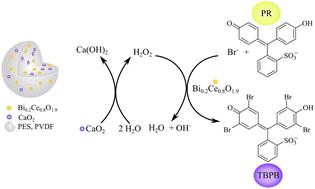Our official English website, www.x-mol.net, welcomes your
feedback! (Note: you will need to create a separate account there.)
In situ generation of H2O2 using CaO2 as peroxide storage depot for haloperoxidase mimicry with surface-tailored Bi-doped mesoporous CeO2 nanozymes
Nanoscale ( IF 5.8 ) Pub Date : 2022-10-24 , DOI: 10.1039/d2nr02575b Eva Pütz 1 , Ina Tutzschky 1 , Hajo Frerichs 1 , Wolfgang Tremel 1
Nanoscale ( IF 5.8 ) Pub Date : 2022-10-24 , DOI: 10.1039/d2nr02575b Eva Pütz 1 , Ina Tutzschky 1 , Hajo Frerichs 1 , Wolfgang Tremel 1
Affiliation

|
Designing the size, morphology and interfacial charge of catalyst particles at the nanometer scale can enhance their performance. We demonstrate this with nanoceria which is a functional mimic of haloperoxidases, a group of enzymes that halogenates organic substrates in the presence of hydrogen peroxide. These reactions in aqueous solution require the presence of H2O2. We demonstrate in situ generation of H2O2 from a CaO2 reservoir in polyether sulfone (PES) and poly(vinylidene fluoride) (PVDF) polymer beads, which circumvents the external addition of H2O2 and expands the scope of applications for haloperoxidase reactions. The catalytic activity of nanoceria was enhanced significantly by Bi3+ substitution. Bi-doped mesoporous ceria nanoparticles with tunable surface properties were prepared by changing the reaction time. Increasing reaction time increases the surface area SBET of the mesoporous Bi0.2Ce0.8O1.9 nanoparticles and the Ce3+/Ce4+ ratio, which is associated with the ζ-potential. In this way, the catalytic activity of nanoceria could be tuned in a straightforward manner. H2O2 required for the reaction was released steadily over a long period of time from a CaO2 storage depot incorporated in polyether sulfone (PES) and poly(vinylidene fluoride) (PVDF) beads together with Bi0.2Ce0.8O1.9 particles, which may be used as precision fillers and templates for biological applications. The spheres are prepared as a dry powder with no surface functionalization or coatings. They are inert, chemically stable, and safe for handling. The feasibility of this approach was demonstrated using a haloperoxidase assay.
中文翻译:

使用 CaO2 作为过氧化物储存库原位生成 H2O2,用于表面定制的掺杂双介孔 CeO2 纳米酶的卤过氧化物酶模拟
在纳米尺度上设计催化剂颗粒的尺寸、形态和界面电荷可以提高它们的性能。我们用 nanoceria 证明了这一点,它是卤素过氧化物酶的功能模拟物,卤素过氧化物酶是一组在过氧化氢存在下卤化有机底物的酶。这些在水溶液中的反应需要 H 2 O 2的存在。我们展示了从聚醚砜 (PES) 和聚偏二氟乙烯 (PVDF) 聚合物珠中的 CaO 2储层原位生成 H 2 O 2,这避免了外部添加 H 2 O 2并扩大了卤过氧化物酶反应的应用范围。Bi 3+取代显着增强了纳米二氧化铈的催化活性。通过改变反应时间制备了具有可调表面性质的双掺杂介孔二氧化铈纳米颗粒。增加反应时间会增加中孔 Bi 0.2 Ce 0.8 O 1.9纳米粒子的表面积S BET和 Ce 3+ /Ce 4+比率,这与ζ电位有关。通过这种方式,可以直接调整纳米二氧化铈的催化活性。H 2 O 2反应所需的物质在很长一段时间内从聚醚砜 (PES) 和聚偏二氟乙烯 (PVDF) 珠粒中与 Bi 0.2 Ce 0.8 O 1.9颗粒结合的 CaO 2储存库中稳定释放,可用于作为生物应用的精密填料和模板。这些球体被制备成没有表面功能化或涂层的干粉。它们是惰性的、化学稳定的并且可以安全处理。使用卤过氧化物酶测定证明了这种方法的可行性。
更新日期:2022-10-26
中文翻译:

使用 CaO2 作为过氧化物储存库原位生成 H2O2,用于表面定制的掺杂双介孔 CeO2 纳米酶的卤过氧化物酶模拟
在纳米尺度上设计催化剂颗粒的尺寸、形态和界面电荷可以提高它们的性能。我们用 nanoceria 证明了这一点,它是卤素过氧化物酶的功能模拟物,卤素过氧化物酶是一组在过氧化氢存在下卤化有机底物的酶。这些在水溶液中的反应需要 H 2 O 2的存在。我们展示了从聚醚砜 (PES) 和聚偏二氟乙烯 (PVDF) 聚合物珠中的 CaO 2储层原位生成 H 2 O 2,这避免了外部添加 H 2 O 2并扩大了卤过氧化物酶反应的应用范围。Bi 3+取代显着增强了纳米二氧化铈的催化活性。通过改变反应时间制备了具有可调表面性质的双掺杂介孔二氧化铈纳米颗粒。增加反应时间会增加中孔 Bi 0.2 Ce 0.8 O 1.9纳米粒子的表面积S BET和 Ce 3+ /Ce 4+比率,这与ζ电位有关。通过这种方式,可以直接调整纳米二氧化铈的催化活性。H 2 O 2反应所需的物质在很长一段时间内从聚醚砜 (PES) 和聚偏二氟乙烯 (PVDF) 珠粒中与 Bi 0.2 Ce 0.8 O 1.9颗粒结合的 CaO 2储存库中稳定释放,可用于作为生物应用的精密填料和模板。这些球体被制备成没有表面功能化或涂层的干粉。它们是惰性的、化学稳定的并且可以安全处理。使用卤过氧化物酶测定证明了这种方法的可行性。

































 京公网安备 11010802027423号
京公网安备 11010802027423号